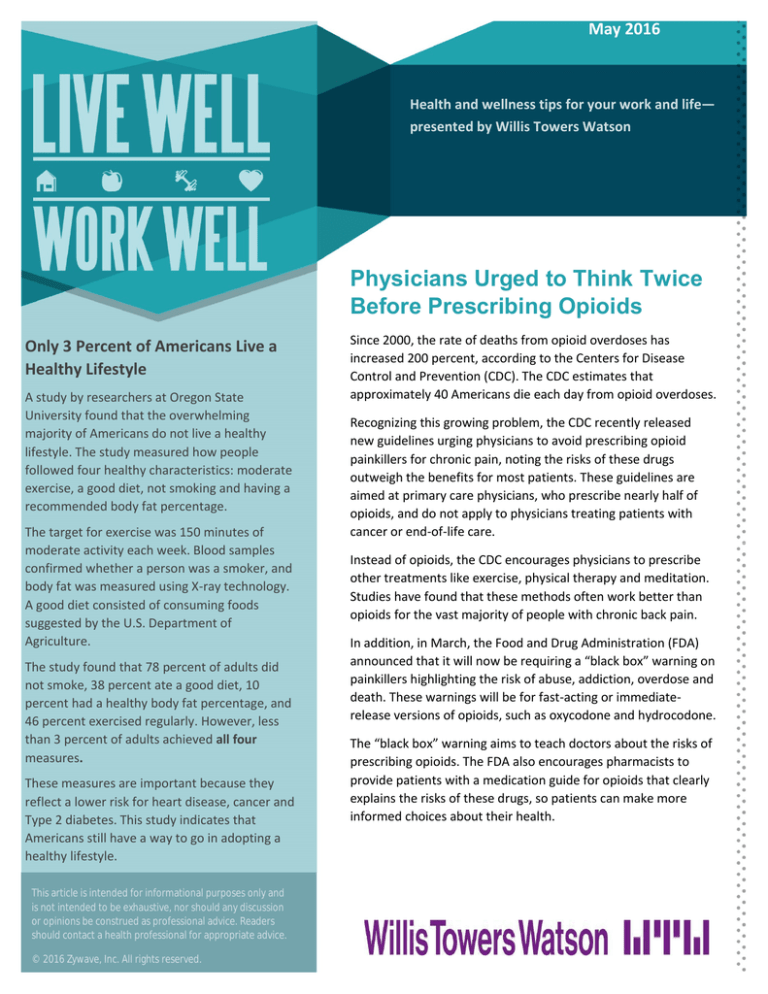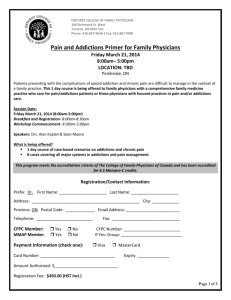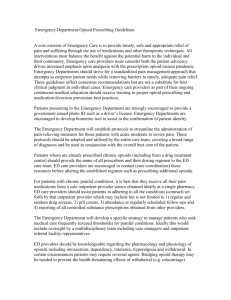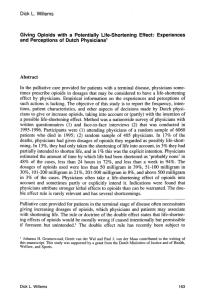Physicians Urged to Think Twice Before Prescribing Opioids May 2016
advertisement

May 2016 Health and wellness tips for your work and life— presented by Willis Towers Watson Physicians Urged to Think Twice Before Prescribing Opioids Only 3 Percent of Americans Live a Healthy Lifestyle A study by researchers at Oregon State University found that the overwhelming majority of Americans do not live a healthy lifestyle. The study measured how people followed four healthy characteristics: moderate exercise, a good diet, not smoking and having a recommended body fat percentage. The target for exercise was 150 minutes of moderate activity each week. Blood samples confirmed whether a person was a smoker, and body fat was measured using X-ray technology. A good diet consisted of consuming foods suggested by the U.S. Department of Agriculture. The study found that 78 percent of adults did not smoke, 38 percent ate a good diet, 10 percent had a healthy body fat percentage, and 46 percent exercised regularly. However, less than 3 percent of adults achieved all four measures. These measures are important because they reflect a lower risk for heart disease, cancer and Type 2 diabetes. This study indicates that Americans still have a way to go in adopting a healthy lifestyle. This article is intended for informational purposes only and is not intended to be exhaustive, nor should any discussion or opinions be construed as professional advice. Readers should contact a health professional for appropriate advice. © 2016 Zywave, Inc. All rights reserved. Since 2000, the rate of deaths from opioid overdoses has increased 200 percent, according to the Centers for Disease Control and Prevention (CDC). The CDC estimates that approximately 40 Americans die each day from opioid overdoses. Recognizing this growing problem, the CDC recently released new guidelines urging physicians to avoid prescribing opioid painkillers for chronic pain, noting the risks of these drugs outweigh the benefits for most patients. These guidelines are aimed at primary care physicians, who prescribe nearly half of opioids, and do not apply to physicians treating patients with cancer or end-of-life care. Instead of opioids, the CDC encourages physicians to prescribe other treatments like exercise, physical therapy and meditation. Studies have found that these methods often work better than opioids for the vast majority of people with chronic back pain. In addition, in March, the Food and Drug Administration (FDA) announced that it will now be requiring a “black box” warning on painkillers highlighting the risk of abuse, addiction, overdose and death. These warnings will be for fast-acting or immediaterelease versions of opioids, such as oxycodone and hydrocodone. The “black box” warning aims to teach doctors about the risks of prescribing opioids. The FDA also encourages pharmacists to provide patients with a medication guide for opioids that clearly explains the risks of these drugs, so patients can make more informed choices about their health. STRAWBERRY MANGO FETA TOAST 1 ripe mango (divided) 2 cups strawberries (divided) ½ cup fat-free feta cheese crumbles 2 Tbsp. balsamic vinegar 1 cup basil leaves (plus 2 tablespoons for topping) 2 Tbsp. olive oil 4 slices of whole-wheat bread Directions Peel and pit mango. Dice ¾ of mango and ¾ of strawberries, and place in a large bowl with feta cheese. Put remaining fruit, ¼ cup basil, vinegar and oil in a blender and blend well. Pour blended vinaigrette over fruit-feta mix and toss gently. Chop remaining basil leaves, toast bread slices and cut each slice diagonally. Top toast with dressed fruit-feta mix and chopped basil. Makes: 4 servings Nutritional Information (per serving) Total Calories 240 Total Fat 8g Protein 17 g Carbohydrates 33 g Dietary Fiber 5g Saturated Fat 2g Sodium 390 mg *Percent Daily Values are based on a 2,000 calorie diet. Source: USDA May is National Stroke Awareness Month Every 40 seconds, someone in the United States has a stroke. Strokes occur when blood flow to the brain is blocked by a clot. The brain cells in the immediate area then begin to die because they are not receiving the oxygen and nutrients they need to stay alive. Approximately 128,000 people die from strokes each year, and strokes are one of the leading causes of long-term disability in the United States. Common risk factors include high blood pressure, high cholesterol, smoking, diabetes and obesity. While strokes most often happen to the elderly, 25 percent of all strokes occur in those under the age of 60. Each May, health organizations across the United States work to raise awareness of strokes and their symptoms. Common stroke symptoms include facial drooping, weakness on one side of the body and speech difficulty. In addition to being able to recognize stroke symptoms, it is important to know what you can do reduce your chances of having a stroke. The infographic below outlines some of the steps you can take to start improving your health today.






